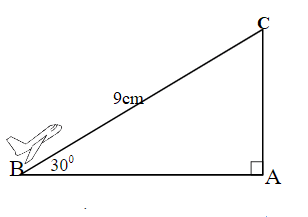Đề thi giữa kì 1 môn Toán lớp 9 - Đề số 3 Đề kiểm tra giữa kì 1 Toán 9
Đề thi giữa kì 1 Toán 9 - Đề số 3
Đề thi giữa kì 1 Toán 9 - Đề số 3 được Giaitoan.com biên soạn bao gồm các dạng bài tập và đáp án chi tiết được xây dựng theo trọng tâm chương trình học THCS giúp học sinh ôn tập, củng cố kiến thức, giúp định vị khả năng tư duy logic, khả năng nhận biết. Đây là nền tảng vững chắc giúp các bạn tự tin làm bài trong các kì thi và kiểm tra định kì môn Toán 9. Mời các bạn cùng tham khảo chi tiết!
A. Đề thi Toán giữa kì 1 lớp 9
Câu 1: Thực hiện phép tính

Câu 2: Giải phương trình:

Câu 3: Cho hai biểu thức ![]() và
và ![]() ( với )
( với )
a) Tính giá trị của A biết x = 16
b) Rút gọn B
c) Tìm các giá trị nguyên của x để P = A. B có giá trị nguyên
Câu 4: Một chiếc máy bay cất cánh. Đường bay lên tạo với phương ngang một góc ![]() sau khi bay được quãng đường 9 km thì máy bay đã bay lên được độ cao là bao nhiêu km theo phương thẳng đứng
sau khi bay được quãng đường 9 km thì máy bay đã bay lên được độ cao là bao nhiêu km theo phương thẳng đứng
Câu 5: Cho tam giác ABC nhọn có đường cao AH. Gọi M là hình chiếu của H lên AB
a) Biết AM = 3 cm; BM = 9 cm. Tính AH; HM
b) Kẻ IM vuông góc với AC tại N. Chứng minh AB. AM = AC. AN
c) Đường thẳng qua A vuông góc với MN cắt BC tại D; MN cắt AH tại O. Chứng minh rằng ![]()
Câu 6: Tìm giá trị lớn nhất của biểu thức: ![]()
B. Đáp án Đề thi giữa kì 1 lớp 9 môn Toán
Câu 1: Thực hiện phép tính

Hướng dẫn giải

Câu 2: Giải phương trình:

Hướng dẫn giải

Vậy phương trình có nghiêm x = 4

Vậy phương trình có nghiệm x = 3

Vậy phương trình có nghiệm x = -1 ; x= 4
Câu 3: Cho hai biểu thức  và
và ![]() ( với )
( với )
a) Tính giá trị của A biết x = 16
b) Rút gọn B
c) Tìm các giá trị nguyên của x để P = A. B có giá trị nguyên
Hướng dẫn giải
a) Với x = 16 thì 
b)

c) Ta có: 
Để P nguyên thì ![]()
Với

Vậy x = 9 thì P = A. B có giá trị nguyên
Câu 4: Một chiếc máy bay cất cánh. Đường bay lên tạo với phương ngang một góc sau khi bay được quãng đường 9 km thì máy bay đã bay lên được độ cao là bao nhiêu km theo phương thẳng đứng
Hướng dẫn giải

Xét tam giác vuông tại A ta có:
![]()
Vậy máy bay đã bay được 4,5 km so với phương thẳng đứng
Câu 5: Cho tam giác ABC nhọn có đường cao AH. Gọi M là hình chiếu của H lên AB
a) Biết AM = 3 cm; BM = 9 cm. Tính AH; HM
b) Kẻ IM vuông góc với AC tại N. Chứng minh AB. AM = AC. AN
c) Đường thẳng qua A vuông góc với MN cắt BC tại D; MN cắt AH tại O. Chứng minh rằng ![]()
Hướng dẫn giải

a) Ta có: AB = AM + BM = 3 + 9 = 12 cm
Áp dụng hệ thức lượng trong tam giác ABH vuông tại H ta được:

b) Áp dụng hệ thức lượng trong tam giác ABH có: ![]() (1)
(1)
Áp dụng hệ thức lượng trong tam giác AHC có: ![]() (2)
(2)
Từ (1) và (2) ta được ![]()
c) Gọi K là giao điểm của AD và MN
Ta có: ![]()
Dễ dàng chứng minh được ![]() có:
có:
![]() là góc chung
là góc chung
![]()
![]()
Mà ![]()
![]()
Từ (1) và (2) ta được

Câu 6: Tìm giá trị lớn nhất của biểu thức: ![]()
Hướng dẫn giải

![]() hay
hay ![]()
Dấu “ =” xảy ra khi 
Vậy GTLN của ![]() khi
khi ![]()
Tài liệu liên quan:
- Đề thi giữa kì 1 Toán 9 - Đề số 4
- Đề thi giữa kì 1 Toán 9 - Đề số 2
Trên đây Giaitoan.com giới thiệu tới quý thầy cô và bạn đọc tài liệu Đề kiểm tra giữa học kì 1 môn Toán 9 - Đề 3. Ngoài ra học sinh có thể tham khảo thêm một số tài liệu liên quan: Lý thuyết Toán 9, Luyện tập Toán 9, Giải Toán 9 Tập 1, ....




























